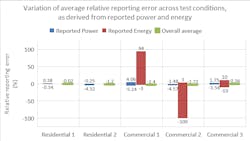DOE PNNL studies how advanced SSL might self-report energy consumption (UPDATED)
The US Department of Energy (DOE) Pacific Northwest National Laboratory (PNNL) has released a new research report on the evaluation of AC power sockets that can monitor and report energy usage. The research took place at PNNL’s Connected Lighting Test Bed where the lab has studied numerous solid-state lighting (SSL) issues such as dimming. The latest research is intended to open and advance a discussion about how intelligent LED-based lighting products might self-report energy usage and why such a capability might be important.
We have previously covered energy metering in LED lighting mainly relative to outdoor street and area lighting. Traditionally, utilities billed municipalities and other owners of such outdoor lighting based on fixed tariffs. But LED lighting brought the need for billing based on actual energy usage given the inherent efficiency of LED sources and the fact that many outdoor products are now dimmed based on time of night or traffic. The topic has regularly been a point of contention at events such as the IES Street & Area Lighting Conference.
The need for metering indoors comes from a different perspective. Commercial buildings are metered already for billing purposes. But regulatory issues create a problem with respect to advanced SSL technologies such as tunable lighting. Buildings are required to meet a prescribed power density in terms of kWh/ft2. And that figure of merit is generally based on the maximum power an SSL product might consume and general guidelines about hours of usage per day, month, or year.
Advanced SSL luminaires that have multiple LED channels for tunability and health and wellbeing purposes might have a theoretical maximum based on all channels operating at full power that in actual scenarios would never happen. Moreover, the intelligence and connectivity present in many state-of-the-art luminaires will also add to the power draw. Ultimately, building owners and facility managers will need to know how much energy is being used by advanced lighting products. Furthermore, regulatory policy needs to recognize the capabilities of such technology, even if it requires energy monitoring to allow usage of the technology.
Already there are luminaires on the market that can report energy usage, but the installed base of such products is low. Moreover, there are no standards for how such data would be reported or for accuracy or precision requirements. The PNNL research should start a process toward some standardization in implementations, data formats, and measurement technology.
The initial PNNL testing was very elementary. The lab tested two residentially-targeted AC wall sockets to which a lamp or other AC-powered appliance could be connected. And the lab tested three commercially-targeted products that had a large array of AC sockets with the capability of monitoring the load connected to each. A precision meter was placed in line with each load to measure a reference current for comparison with the data collected by the sockets.
The results of this initial testing were underwhelming. Surprisingly, the residentially-targeted sockets were slightly more accurate than the commercially-targeted sockets. In both cases, the sockets could report power consumption at any specific point in time. The commercial products could also sample usage over time and deliver cumulative energy usage. The cumulative capabilities lacked precision with variation as high as 17%. The lack of precision was surprising due to the fact that the reporting was mathematically generated using internal integration of gathered data, as compared to manual external integration. Speculation is that issues with reporting resolution enhanced the range of what the PNNL called RRE (relative reporting error).
Still, all of the products could measure instantaneous power usage with accuracy within 2% of reference. And that is the figure of merit that utilities have established for use in street light utility-grade meters. These initial tests, however, are just a starting point. Ultimately, PNNL’s work should influence standards bodies, regulatory agencies, market transformation programs, and more.
You can download the complete report as a PDF from the DOE SSL website.
*Updated Aug. 25, 2020 4:26 PM for clarification on relative reporting error (RRE).
For up-to-the-minute LED and SSL updates, why not follow us on Twitter? You’ll find curated content and commentary, as well as information on industry events, webcasts, and surveys on our LinkedIn Company Page and our Facebook page.

Maury Wright | Editor in Chief
Maury Wright is an electronics engineer turned technology journalist, who has focused specifically on the LED & Lighting industry for the past decade. Wright first wrote for LEDs Magazine as a contractor in 2010, and took over as Editor-in-Chief in 2012. He has broad experience in technology areas ranging from microprocessors to digital media to wireless networks that he gained over 30 years in the trade press. Wright has experience running global editorial operations, such as during his tenure as worldwide editorial director of EDN Magazine, and has been instrumental in launching publication websites going back to the earliest days of the Internet. Wright has won numerous industry awards, including multiple ASBPE national awards for B2B journalism excellence, and has received finalist recognition for LEDs Magazine in the FOLIO Eddie Awards. He received a BS in electrical engineering from Auburn University.





